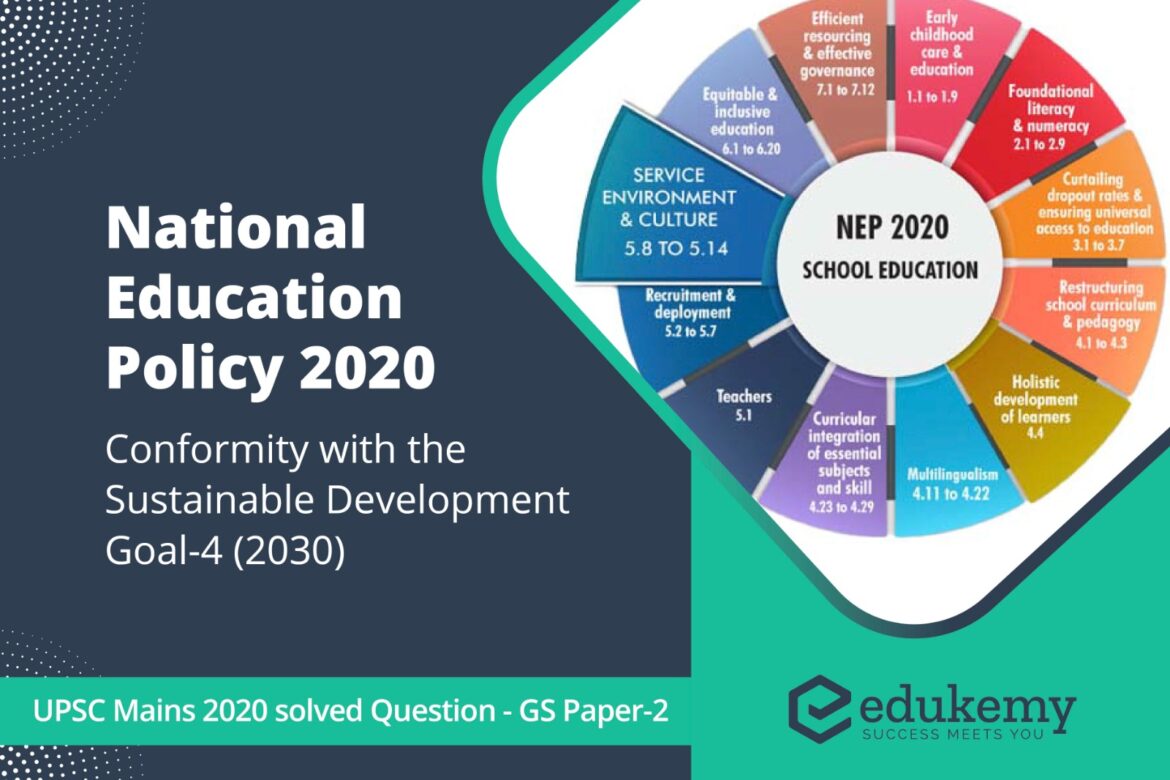The National Education Policy (NEP) 2020 in India is designed with a commitment to align with the global education agenda, particularly the Sustainable Development Goal 4 (SDG-4) that focuses on ensuring inclusive and equitable quality education for all by 2030. The NEP 2020 aims to comprehensively restructure and reorient the education system in India to address contemporary challenges and foster holistic development. It emphasizes a learner-centric approach, promoting critical thinking, creativity, and a multidisciplinary approach to education. The policy also aims to bridge gaps in access and quality, promoting a flexible and inclusive system that accommodates diverse learning needs. However, a critical examination of the statement requires an assessment of the actual implementation of the policy. Challenges such as resource allocation, infrastructure development, and the adaptation of educational institutions to the new framework need to be addressed to ensure that the NEP 2020 effectively contributes to achieving the objectives set under SDG-4. The success of the policy will depend on the sustained commitment of stakeholders, including government bodies, educational institutions, and the community, to navigate and overcome the hurdles in the path towards educational reform.
UPSC Mains General Studies Paper – 2 Mains 2020
Issues relating to development and management of Social Sector/Services relating to Health, Education, Human Resources
UPSC Mains Civil Services IAS Exam Question Paper – 2020
Contents
- 1 Structure of the Question
- 2 Answer
- 3 Conclusion
- 4 Frequently Asked Questions (FAQs)
- 4.1 FAQ 1: How does the National Education Policy 2020 align with Sustainable Development Goal-4 (2030)?
- 4.2 FAQ 2: In what ways does the NEP 2020 seek to restructure and reorient the education system in India?
- 4.3 FAQ 3: How does the NEP 2020 address the issue of skill development in the context of Sustainable Development Goal-4?
- 4.4 FAQ 4: Does the NEP 2020 adequately address issues of inclusivity and diversity in education?
- 4.5 FAQ 5: How does the NEP 2020 encourage research and innovation in the education sector?
Structure of the Question
- In Introduction,
- Try to define Sustainable Development Goals (SDG) and link NEP with SDG-4.
- In Body,
- Elaborate about NEP, 2020 by SDG-4 restructuring and reorienting the education system.
- Challenges associated with NEP,2020.
- In Conclusion,
- NEP, 2020 and SDG-4 joint impact on improved education- Gamechanger for the nation
Answer
Introduction
The Agenda contains 17 Goals including a new global education goal (SDG 4) that aims to “Ensure inclusive and equitable quality education and promote lifelong learning opportunities for all by 2030” with seven targets and three means of implementation. Recently, the Government announced the New Education Policy (NEP) 2020, which will replace the National Policy on Education, 1986. The Sustainable Development Goal (SDG) 4 aims to “Ensure inclusive and equitable quality education and promote lifelong learning opportunities for all by 2030”.
NEP-2020 Complying with SDG-4 to Restructure and Reorient the Education System in India
- Promote free primary and secondary education and universal literacy and numeracy (SDG 4.1 and 4.6): This aims at universalization of education from preschool to secondary level with a 100% Gross Enrollment Ratio (GER) in school education by 2030.
- Eliminate all discrimination in education (SDG 4.5): NEP focuses on bringing 2 crores out-of-school children back into the mainstream through an open schooling system.
- Equal access to quality pre-primary education (SDG 4.2): The Policy also recognizes the importance of the crucial early stage for the development of mental faculties of a child by bringing an uncovered age group of 3-6 years under school curriculum with three years of Anganwadi/pre-schooling.
- Access for all women and men to affordable and quality technical, Vocational, and tertiary education, including University (SDG 4.3): NEP emphasizes vocational education from class 6 with internships. The policy revamps undergraduate education with a flexible curriculum of 3 or 4 years with multiple exit options and appropriate certification.
- Substantially increase the supply of qualified teachers in developing countries(SDG 4.C): A Common National Professional Standards for Teachers(NPST) will be developed by 2022, in consultation with NCERT, SCERTs, teachers, and export organizations from across levels and regions.
Following challenges to NEP,2020 are to be tackled:
- Incongruence in Knowledge and Jobs: There is a persistent mismatch between the knowledge & skills imparted and the jobs available. This has been one of the main challenges that have affected the Indian education system since Independence.
- Federal Issues: NEP is suggestive of over-centralization even though education is a concurrent subject in India’s federal structure. Education is a concurrent subject, and most states have their school boards. Therefore, state governments would have to be brought on board for the actual implementation of this decision.
- Issues with Three Language Formula: Many of the states especially in South India have always been very skeptical about it and have seen it as an imposition of Hindi. Also, providing education till 5th class in the mother language may make it difficult for students to switch to the global language English, suddenly in Class 6th.
- Lack of Funds and Infrastructure: The effective implementation of policy coupled with sufficient financing may become the defining factor of its success.

Conclusion
Therefore the new National Education Policy of 2020 that conforms with the SDG-4 can ensure a truly inclusive education system in terms of aspects like gender, class, and age group. This has for the first time realized the importance of cognitive development during the preschool phase of a child. So, with the right implementation of the NEP, it can be apt to say that New India’s nation-building will happen with the transformed education.
Read our SOLVED PAPERS.
Frequently Asked Questions (FAQs)
FAQ 1: How does the National Education Policy 2020 align with Sustainable Development Goal-4 (2030)?
Answer: The National Education Policy 2020 aligns with Sustainable Development Goal-4 (2030) by emphasizing inclusive and equitable quality education. It focuses on providing universal access to quality education, promoting lifelong learning opportunities, and addressing the diverse needs of learners, thereby contributing to the global goal of ensuring inclusive and equitable education for all.
FAQ 2: In what ways does the NEP 2020 seek to restructure and reorient the education system in India?
Answer: The National Education Policy 2020 aims to restructure the education system in India by introducing key reforms such as a 5+3+3+4 curricular structure, flexibility in subject choices, emphasis on holistic development, vocational education integration, and the establishment of a National Research Foundation. These changes are designed to promote critical thinking, creativity, and a multidisciplinary approach, fostering a more learner-centric and skill-oriented education system.
FAQ 3: How does the NEP 2020 address the issue of skill development in the context of Sustainable Development Goal-4?
Answer: The National Education Policy 2020 places a significant emphasis on skill development, aligning with the objectives of Sustainable Development Goal-4. It integrates vocational education from the school level, promotes experiential learning, and encourages multidisciplinary studies. By fostering a holistic and skill-oriented education approach, NEP 2020 aims to equip learners with the necessary skills for employment and lifelong learning, contributing to the achievement of SDG-4 targets.
FAQ 4: Does the NEP 2020 adequately address issues of inclusivity and diversity in education?
Answer: The National Education Policy 2020 includes provisions to address inclusivity and diversity in education. It emphasizes the importance of providing education in the mother tongue or regional language, aims to reduce the dropout rate of girls, and promotes special education zones for disadvantaged regions. However, the successful implementation of these policies remains a challenge, and continued efforts are needed to ensure equitable access to quality education for all, aligning with the principles of SDG-4.
FAQ 5: How does the NEP 2020 encourage research and innovation in the education sector?
Answer: The National Education Policy 2020 seeks to promote research and innovation through the establishment of the National Research Foundation (NRF) and by encouraging a culture of research in higher education institutions. The NRF aims to fund, coordinate, and promote research across disciplines. While these initiatives align with the spirit of SDG-4, the critical examination requires ongoing assessment of the implementation and effectiveness of these measures to ensure meaningful contributions to the advancement of education and sustainable development goals.
For UPSC Prelims Resources, Click here
For Daily Updates and Study Material:
Join our Telegram Channel – Edukemy for IAS
- 1. Learn through Videos – here
- 2. Be Exam Ready by Practicing Daily MCQs – here
- 3. Daily Newsletter – Get all your Current Affairs Covered – here
- 4. Mains Answer Writing Practice – here
Visit our YouTube Channel – here



